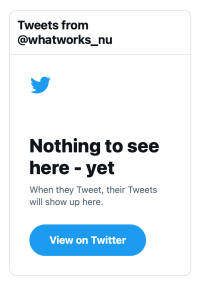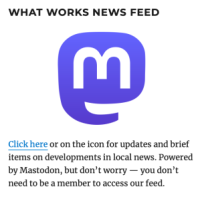
Elon Musk isn’t laughing with us. He’s laughing at us. Photo (cc) 2022 by Steve Jurvetson.
Update: Ivan Mehta of TechCrunch reports that Twitter may have already reversed itself on requiring log-ins to view tweets. I’ll test it later and think about whether I want to go to the trouble of restoring our Twitter timeline to What Works.
Today I want to return to a topic that I write about from time to time: the ongoing travails of Twitter under Elon Musk and the future of what I’ll call short-form interactive social media, which some people still refer to as “microblogging.” It’s something that’s of no interest to the vast majority of people (and if I’m describing you, then you have my congratulations and admiration) but of tremendous interest to a few of us.
You may have heard that a number of changes hit Twitter over the weekend, some deliberate, some perhaps accidental. They cut back on the number of posts you could read before encountering a “rate limit” of 600 per day for non-subscribers and 6,000 a day for those who pay $8 a month. Those limits were later raised. Now, very few people are paying $8 for those blue check marks and extra privileges, and you can reach 600 (or 800, or 1,000, or whatever it is at the moment) pretty quickly if you’re zipping through your timeline. It was and is a bizarre limitation, since it means that users will spend less time on the site and will see fewer of Twitter’s declining inventory of ads.
Twitter also got rid of its classic TweetDeck application, which lets you set up columns for lists, notifications and the like, and switched everyone over to a new, inferior version — and then announced that TweetDeck will soon be restricted to those $8-a-month customers.
Finally, and of the greatest significance to me and my work, you can no longer view a tweet unless you’re actually logged in to Twitter. We’ve all become accustomed to news outlets embedding tweets in stories. I do it myself sometimes. Well, now that has stopped working. Maybe it’s not that big a deal. After all, you can take a screenshot and/or quote from it, just as you can from any source. But it’s an extra hassle for both publishers and readers.
Moreover, this had a significant negative effect on What Works, the website about the future of local news that Ellen Clegg and I host. Just recently, I decide to add a news feed of updates and brief items to the right-hand rail, powered by Twitter. It was a convenient way of informing our readers regardless of whether they were Twitter users. And on Monday, it disappeared. What I’ve come up with to replace it is a half-solution: A box that links to our Mastodon account, which can still be read by Mastodon nonusers and users alike. But it’s an extra step. In order to add an actual Mastodon news feed we would either need to pay more or switch to a hosting service and put up with the attendant technical challenges.
What is Musk up to? I can’t imagine that he’s literally trying to destroy Twitter; but if he were, he’d be doing exactly what he’s doing. It’s strange. Twitter is now being inundated with competitors, the largest of which is Mastodon, a decentralized system that runs mainly on volunteer labor. But Twitter co-founder Jack Dorsey is slowly unveiling a very Twitter-like service called Bluesky (still in beta, and, for the moment, invitation-only), and, this Thursday, Facebook (I refuse to call it Meta) will debut Threads. If Mark Zuckerberg doesn’t screw it up, I think Threads, which is tied to Instagram, might prove to be a formidable challenger.
Still, what made Twitter compelling was that it was essentially the sole platform for short-form interactive social media. The breakdown of that audience into various niches makes it harder for any one service to benefit from the network effect. I’ve currently got conversations going on in three different places, and when I want to share links to my work, I now have to go to Twitter, Mastodon and Bluesky (which I just joined), not to mention Facebook and LinkedIn.
And speaking of the network effect: Twitter may be shrinking, but, with 330 million active monthly users, it’s still by far the largest of the three short-form platforms. Mastodon was up to 10 million registered users as of March (that number grows in spurts every time Musk indulges his inner sociopath), and Bluesky has just 100,000 — although another 2 million or so are on the wait list. What that means for my work is that just a handful of the media thought leaders I need to follow and interact with are on Mastodon or Bluesky, and, from what I can tell, none (as in zero) of the people and organizations that track developments in local news have budged from Twitter.
It will likely turn out that the social media era was brief and its demise unlamented. In the meantime, what’s going on is weird and — for those of us who depend on this stuff — aggravating. In some ways, I would like to see one-stop short-form social media continue. My money is on Threads, although I suspect that Zuckerberg’s greed will prevent it from realizing its full potential.



 The folks who run Twitter are starting to lose their tolerance for third-party clients,
The folks who run Twitter are starting to lose their tolerance for third-party clients,